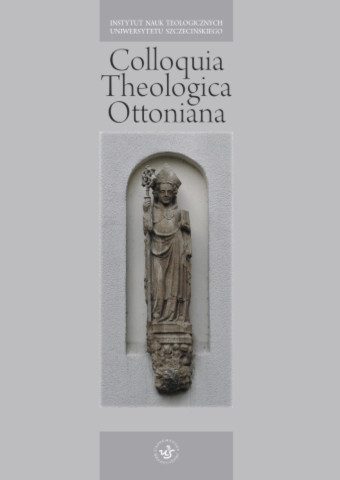
ISSN: 1731-0555
eISSN: 2353-2998
OAI
DOI: 10.18276/cto.2019.2-02





Issue archive /
2/2019
Ingerencje władz państwowych w sprawowanie kultu publicznego na przykładzie działań zielonogórskiej administracji wyznaniowej wobec Kościoła gorzowskiego w latach 1945-1972
(Interventions of state authorities in the exercise of public worship on the example of the activities of the religious administration of Zielona Góra against the Gorzów Church in 1945–1972)
| Authors: |
Dariusz
Mazurkiewicz

Uniwersytet Szczeciński |
| Keywords: | Bureau for religious affairs Gorzów Church public worship freedom of conscience and religion |
| Data publikacji całości: | 2019-12 |
| Page range: | 21 (35-55) |
Abstract
After World War II, the state authorities of the People’s Poland in a planned way departed from the principle of ideological neutrality of the state. In its place came the thesis stating the need for far-reaching intervention in matters of conscience and religion of citizens. As a result, the communist authorities tried to interfere in both human consciences and impede the exercise of the right to public profession of faith. The Bureau for religious
affairs established in 1950 played a special role in the denominational policy of the state. His real task was to oversee and fight the Catholic Church and other denominations. He did not run an independent policy, but performed the tasks assigned by the political bureau of the Central Committee of the PZPR. In voivodeships, in turn, policy towards religion was implemented by departments for religious affairs. The department in Zielona Góra,
among many actions aimed at the functioning of the Gorzów Church, interfered in the exercise of public worship. His actions consisted in hindering pilgrimages, services and celebrations. The apogee of the department’s hostile actions towards the Church occurred during the peregrination of the image of Our Lady of Częstochowa and the millennium of the baptism of Poland, when by all possible and often unlawful methods, religious
administration employees tried to prevent the participation of the faithful in services. The repression used against the clergy and lay faithful did not bring the expected results. The externalized forms of religiosity could not be removed from the public space, what is more, attempts to interfere in the performance of public worship not only did not result in atheisation of society, but resulted in even greater participation of the faithful in religious
ceremonies.
Download file
Article file
Bibliography
| 1. | Archiwum Akt Nowych w Warszawie, akta Urzędu do Spraw Wyznań, sygn. 37/169, 78/93a, 125/576. |
| 2. | Archiwum Państwowe w Zielonej Górze, akta Wydziału do Spraw Wyznań, sygn. 2898, 2900, 2901, 2935, 2936, 2937, 2940, 2941, 2942, 2947, 2951, 2952, 2953, 3221. |
| 3. | Dekret Rady Ministrów z dnia 18 sierpnia 1949 r. o zmianie niektórych przepisów o zgromadzeniach, Dz.U. z 1949 r., nr 49, poz. 369. |
| 4. | Dekret Rady Ministrów z dnia 5 sierpnia 1949 r. o ochronie wolności sumienia i wyznania, Dz.U. z 1949 r., nr 45, poz. 334. |
| 5. | Raina P., Kościół w PRL. Kościół katolicki a państwo w świetle dokumentów 1945–1989, t. 1: Lata 1945–1959, Poznań 1994. |
| 6. | Raina P., Kościół w PRL. Kościół katolicki a państwo w świetle dokumentów 1945–1989, t. 2: Lata 1960–1975, Poznań 1995. |
| 7. | Ustawa z dnia 17 marca 1921 r. Konstytucja Rzeczypospolitej Polskiej, Dz.U. z 1921 r., nr 44, poz. 267. |
| 8. | Ustawa z dnia 29 marca 1962 r. o zgromadzeniach, Dz.U. z 1962 r., nr 20, poz. 89. |
| 9. | Chojnacki G., „Oto Partia: siła ludów i sumienie” – komunistyczna wizja (de)formacji sumienia, „Studia Paradyskie” 28 (2018), s. 145–157. |
| 10. | Dudek A., Gryz R., Komuniści i Kościół w Polsce (1945–1989), Kraków 2006. |
| 11. | Dudek A., Kościół katolicki w Polsce w 1956 roku, „Polska 1944/45–1989. Studia i Materiały” 3 (1997), s. 103–117. |
| 12. | Dudek A., O działaniach antykościelnych władz PRL w latach 1958–1966, „Chrześcijanin w Świecie” 24 (1994) 1, s. 191–204. |
| 13. | Misztal H., Mezglewski A., Zakres kompetencji, styl działania i cele Urzędu do Spraw Wyznań, w: Prawo i polityka wyznaniowa w Polsce Ludowej. Materiały II Ogólnopolskiego Sympozjum Prawa Wyznaniowego (Kazimierz Dolny 26–28 października 2004), red. A. Mezglewski, P. Stanisz, M. Ordon, Lublin 2005, s. 33–70. |
| 14. | Rymar D., Gorzów Wielkopolski w latach 1945–1998. Przemiany społeczno-polityczne, Szczecin–Gorzów 2005. |
| 15. | Sikorski J., Długa droga do przełomu. Państwo a Kościół rzymskokatolicki w województwie zielonogórskim w roku 1956, „Nadwarciański Rocznik Historyczno-Archiwalny” 12 (2005), s. 105–121. |
| 16. | Śmierzchalski-Wachocz D., Partia komunistyczna wobec Kościoła i przejawów wiary katolickiej w swoich szeregach na przykładzie Środkowego Nadodrza w latach 1945–1989, Ząbki 2007. |
| 17. | Wejman G., Organizacja Kościoła katolickiego na Pomorzu Zachodnim w latach 1956–1972, w: Dzieje Kościoła katolickiego na Pomorzu Zachodnim, t. 2: 1956–1972, red. M. Siedziako, Z. Stanuch, G. Wejman, Szczecin–Warszawa 2017, s. 141–174. |